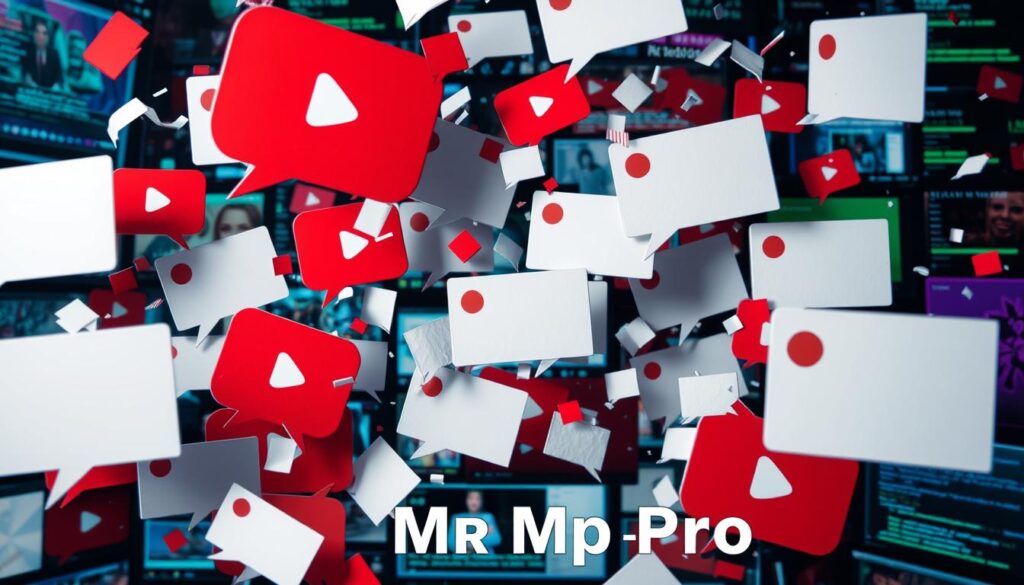
Google+ launched in 2011 aiming to compete with Facebook. It quickly gained 10 million users in two weeks. But, it failed to grow, shutting down in 2019. This failure shows how crucial it is to understand what users want and avoid integration mistakes.
Looking at Google+, you’ll see how it tried but failed to beat Facebook. This led to a loss of user data and damaged its reputation.
The story of Google+ is a warning to big companies. It shows even the biggest can fail in social media. Google+ lasted 7 years but couldn’t beat Facebook and others.
This failure highlights the need to protect user data. It also shows the importance of focusing on what users need when creating a social media platform.
The Birth of Google’s Social Media Ambition
Google’s entry into social media was a big move. Facebook was already huge, with 750 million users. Google wanted to create a platform that could compete with Facebook.
Google+ started with big dreams. It aimed to challenge Facebook’s top spot. But, it faced problems like data breaches and user issues. Google hoped to make more money and improve its services with a social platform.
Google+ had cool features like Hangouts for video calls with friends. It also focused on private sharing. But, it couldn’t beat Facebook’s popularity. It had about 20 million users, much less than Facebook’s 750 million.
The problems Google+ faced are lessons for others. It’s crucial to keep user privacy and security in mind. This helps avoid the mistakes Google+ made.
| Platform | User Base |
|---|---|
| 750 million | |
| Google+ | 20 million |
Understanding the Google+ Platform
Google+ was a social media site where users could share photos and updates. It aimed to offer a full social networking experience. The goal was to be a big name in social media.
Google+ had a special feature called “circles.” It let users sort friends into groups for personal and work life. This was different from other sites.
But, Google+ didn’t catch on. It struggled to listen to user feedback, making it hard to use. It also had a big problem with keeping user data safe. A bug could have exposed data from 500,000 accounts.
- 90% of users left in less than five seconds, showing low interest.
- Up to 438 apps had access to the vulnerable API.
- The site was open for 7 years but many accounts were inactive.
To understand the Google+ fiasco, we need to look at its features and user experience. This helps us see what went wrong. It also shows how future sites can avoid these mistakes to keep user data safe.
| Feature | Description |
|---|---|
| Google+ Circles | Allowed users to segment connections into groups |
| Google+ API | Provided access to user data for third-party applications |
The Launch Strategy and Early Reception
In 2011, Google+ was launched as a social media platform to compete with Facebook. The launch strategy was big, with over 100 launches planned. It had features like Circles, Sparks, Hangouts, and Instant Upload to make sharing easier.
The Google+ project started as an invitation-only Field Trial. It aimed to engage users in over 40 languages. Key features included:
- Circles: for sharing with specific groups
- Sparks: content based on your interests
- Hangouts: group video chats
- Instant Upload: automatic photo and video sharing

The google+ fiasco happened because it didn’t attract many users. Despite its cool features and launch strategy, it was shut down. But, we can learn from Google+ to make better social media platforms in the future.
| Feature | Description |
|---|---|
| Circles | Allowing users to create groups for sharing information with selected people |
| Sparks | Delivering content based on user interests |
| Hangouts | Enabling group video chats |
| Instant Upload | Automatically uploading photos and videos to the platform |
Key Features That Failed to Resonate
Looking at the google+ fiasco, we see some key features didn’t click with users. Circles let users sort their contacts into groups like “friends” and “family”. Hangouts offered group video chats, a unique feature back then.
Yet, despite these cool features, google+ didn’t catch on. Some reasons include:
- Lack of built-in messaging, a big minus compared to others
- Hard to edit posts after they’re up, a big hassle
- Not enough data on user engagement, making it hard to know what users want
The google+ fiasco teaches us a lesson. It shows how crucial it is to know what users want. By looking at what didn’t work, we learn what makes a social media site great. 
| Feature | Description |
|---|---|
| Circles | Allowed users to categorize their connections into groups |
| Hangouts | Enabled group video chats |
The Google+ Fiasco: A Timeline of Decline
Looking into the google+ fiasco, it’s key to grasp its decline timeline. Launched in June 2011, Google+ was touted as a “Facebook Killer.” Yet, it failed to attract many users, with engagement at about 3.3 minutes. This is compared to Facebook’s 7.5 hours.
The platform’s downfall was due to several reasons. A lack of new ideas and changes that upset users were major factors. Some key moments in its decline include:
- A big drop in user engagement, with many spending less time on the site.
- The loss of features after a UI redesign, with many original features gone or greatly reduced.
- The introduction of “Collections,” which, though useful, needed more work.

As the google+ fiasco grew, it was clear Google+ was struggling. The decline timeline shows the platform’s challenges. It’s a lesson for future social media sites.
Forced Integration: The YouTube Comments Controversy
The google+ fiasco led to a big backlash when it was added to YouTube comments. This caused a major social media platform controversy. Many users felt their anonymity was being taken away.
An anti-Google Plus petition got over 112,000 signatures. This showed how much people opposed the policy change.
Users had to use their real names, which many saw as an invasion of privacy. Privacy concerns were huge, with over 100,000 users refusing to use their real names. The situation got worse when spam filters failed to catch offensive terms, like the N-word, which was used 85 times without being flagged.
Many popular YouTubers, like TotalBiscuit and PewDiePie, spoke out against the change. The YouTube Product Forum got 10,000 negative posts in two days. Over 21,000 comments were left on Google’s YouTube video about the change, mostly negative. The controversy stayed in the news for eight days, showing how much people cared and were upset.

- Over 112,000 signatures on an anti-Google Plus petition
- 10,000 negative posts on the YouTube Product Forum within two days
- Over 21,000 negative comments on Google’s YouTube video
- 85 instances of the N-word being used without being flagged by spam filters
The youtube comments controversy shows how important it is to listen to users and protect their privacy. The forced integration of Google+ with YouTube comments caused a big backlash. This shows we need to think more about users when making changes to social media platforms.
Privacy Concerns and Data Breaches
The google+ fiasco shows how a social media platform can risk user data. In 2018, a big breach exposed data of about 500,000 users. This included names, email addresses, birthdays, and more.
A bug in the google+ api let third-party developers see user data. This bug was active since 2015. Over 400 apps might have seen the data, affecting users from 2015 to 2018.
Security Vulnerabilities Exposed
The breach showed the weak spots in google+ security. The bug was found in March 2018, just before GDPR started in May. GDPR could fine companies up to 4% of their global revenue for not reporting breaches.
Impact on User Trust
The breach hurt user trust in google+. Many users worried about their data privacy. It also made users less active, with most sessions lasting less than five seconds.

Regulatory Response
Google faced possible fines for not telling about the breach sooner. But, since it was found just before GDPR, Google wasn’t legally required to report it yet. Now, Google limits what apps can see, like SMS and call logs.
The google+ fiasco highlights the need for privacy and security on social media. As social media grows, companies must keep their platforms safe and follow the law.
| Year | Number of Users Affected | Type of Breach |
|---|---|---|
| 2018 | 500,000 | Software bug in google+ api |
| 2015-2018 | Up to 500,000 | Potential exposure period for user data |
Competition Analysis: Why Facebook Prevailed
Looking at the google+ fiasco, Facebook’s rise to the top played a big role in Google+’s downfall. Facebook was already the top social media site, with over 800 million users worldwide. Google+, on the other hand, reached over 100 million users in its first year but couldn’t keep growing.
Facebook’s success came from its ability to change and grow, while Google+ struggled to find its place. Facebook’s users were more active, spending more time and interacting more. This is shown by Facebook’s 200 million new users in the last year, compared to Google+’s struggle to keep users interested.
Some key factors that helped Facebook succeed include:
- Ability to adapt and evolve
- High user engagement
- Large and active user base
In conclusion, the google+ fiasco shows how crucial competition analysis is in the social media world. Knowing what makes competitors strong or weak helps a platform stand out.

| Platform | Active Users | Growth Rate |
|---|---|---|
| 800 million | 200 million added in the past year | |
| Google+ | 100 million | struggled to sustain growth |
The Business Impact on Google
When you think about the google+ fiasco, it’s key to see how it affected Google’s business. The failure of its social media platform led to a drop in stock price. This drop was because investors lost faith in Google’s ability to succeed in social media.
The brand’s reputation took a hit, too. Many users stopped trusting Google to provide a safe and reliable social media platform. This loss of trust changed Google’s strategy and direction. For example, Google started working on services like Google Pay, which is designed for specific markets, like India.
Financial Implications
The financial fallout from the google+ fiasco was big. Google spent a lot on developing and keeping the platform alive. When google+ failed, Google had to write off these costs, hurting its finances. Also, Google’s reputation as a tech leader suffered, making it harder to attract and keep top talent.
Brand Reputation Effects
The google+ fiasco hurt Google’s brand a lot. Many users were upset and disappointed with how Google handled it. This negative feeling has stuck with Google, making it harder to launch new services and attract users. People are now less optimistic about new Google products, doubting their stability and security.

Internal Corporate Changes
Google made big changes inside the company because of the google+ fiasco. It started focusing on making more specialized services, like Google Pay for India. Google also made its app review process stricter, especially for apps using the Gmail API. These changes aim to make users more confident in their data security and support a variety of useful apps.
Technical Challenges and Infrastructure Issues
The google+ fiasco shows how technical problems can hurt a social media site. Google+ struggled with scalability, or its ability to grow. As more people joined, Google found it hard to keep up with updates and maintenance.
Google+ faced server crashes, data breaches, and slow loading times. These problems made users unhappy and lost their trust. Google+ couldn’t fix these issues, which led to its downfall.
Here are some key technical challenges faced by Google+:
- Scalability issues: Google+ struggled to handle the growing number of users, leading to server crashes and slow loading times.
- Infrastructure issues: The platform’s infrastructure was not designed to handle the increased load, leading to data breaches and other security issues.
- Maintenance issues: Google+ faced significant technical challenges, including scalability and maintenance issues, which affected the platform’s performance and user experience.

In conclusion, Google+ faced big technical and infrastructure problems. These issues hurt its ability to keep users happy and led to its decline.
| Technical Challenge | Impact on Google+ |
|---|---|
| Scalability issues | Server crashes, slow loading times |
| Infrastructure issues | Data breaches, security issues |
| Maintenance issues | Affecting platform performance and user experience |
User Experience Shortcomings
The google+ fiasco shows how a social media platform can fail due to poor user experience. Google+ had a complex and cluttered interface, causing user frustration. It was hard for users to navigate and find what they needed.
Some key issues with Google+ include:
- Interface problems: The platform’s interface was cluttered and hard to use, making it tough to find what users needed.
- Navigation complexities: The navigation menu was confusing, leading users to get lost in the platform.
- Feature overload: Google+ had too many features, overwhelming users and making it hard to use the platform effectively.
According to Forbes, Google+’s demise shows the importance of user experience in social media. The platform failed because it couldn’t provide a seamless and intuitive user experience.
The google+ fiasco reminds us that user experience is key to a social media platform’s success. By focusing on user experience and fixing shortcomings, platforms can boost user engagement and retention. This leads to greater success.
The Decision to Shut Down
When looking at the google+ fiasco, it’s key to know why it was shut down. Low user engagement and high costs were big reasons. In fact, 90% of Google+ user sessions lasted less than five seconds, showing little interest.
A security flaw also hurt Google+, affecting up to 500,000 accounts. This, along with the platform’s failure to gain users, led to its shutdown. Google+ for consumers was closed in August 2019 after a 10-month warning.
Some important stats about the google+ fiasco are:
- Up to 438 apps might have used the API flaw
- 90 percent of Google+ user sessions are less than five seconds long, showing low engagement
- The time when personal data might have been exposed: from 2015 to March 2018
The shutdown of Google+ was likely due to its struggle against other social media sites, like Facebook. As a user, you might have been impacted by this. It’s important to understand why Google+ was shut down.
In summary, Google+ was shut down because of low user interest, high costs, and security issues. It failed to win over users and developers, making it a big failure in social media.
| Platform | User Engagement | Security Vulnerabilities |
|---|---|---|
| Google+ | Low | Yes |
| High | Yes |
Legacy and Impact on Social Media Landscape
The google+ fiasco has left a lasting legacy and impact on the social media landscape. It was expected to change how people interact online. But, its failure taught the industry valuable lessons about user experience and privacy.
One key lesson from google+ is the importance of user experience and privacy. Social media platforms should focus on these areas. They can do this by using strong security measures and being open about how they use data.
The impact of google+ can be seen in how it has shaped newer social media platforms. For example, Facebook and Twitter have added features to improve user experience and protect data. The failure of google+ also led to a shift towards platforms like TikTok and Instagram.
Some important lessons from google+ include:
- Prioritizing user experience and privacy
- Implementing robust security measures
- Being transparent about data collection and usage practices
In conclusion, the google+ fiasco has had a big impact on social media. It has influenced the development of new platforms and changed how users engage with them.
Conclusion
The fall of Google+ is a lesson for any new social media site wanting to take on big names like Facebook. Google’s effort to create a strong competitor was good, but it shows how key user experience, privacy, and keeping up with digital changes are. As the Google+ story unfolds, we see the value of knowing what users want, solving privacy issues, and building a lively community. These were the things Google+ didn’t do well.
Even big names like Google can struggle if they don’t meet user needs and keep up with new trends. Google+ had only 6% of users active at its best, and that number dropped by 90% soon after. This shows how important it is to really know your audience and keep changing to meet their needs.
Google+ may be gone, but it has changed the social media world. Its failure teaches big tech companies that privacy, simplicity, and building a community are key to success. The lessons from Google+ will help shape the future of social media, making sure platforms truly connect with their users.

 The Google+ Fiasco: A Case Study in Failed Social Network
The Google+ Fiasco: A Case Study in Failed Social Network
0 Comment